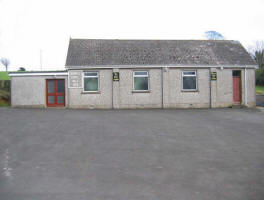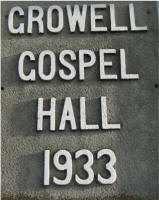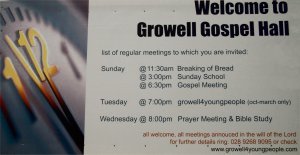
Growell Gospel Hall
 |
 |
| Growell Gospel Hall, built in 1933. | Sign at Growell Gospel Hall. |
 |
Magheraconluce Road, Growell, near Annahilt.
Sunday Service:
Breaking of Bread: 11.30 (every Sunday)
Ministry Meeting: 4.00pm (1st Sunday)
Gospel Meeting: 8.15 (1st Sunday)
Gospel Meeting: 6.00pm (2nd, 3rd and 4th Sunday)
Telephone: 028 9268 9095 or 028 9268 8552
Web site: www.growellgospelhall.com
Email: info@growellgospelhall.com
HISTORY
History of Growell Assembly
About 200 years ago John Wesley visited Ireland and preached
the Gospel in the district between Lisburn and Hillsborough. His
pulpit was a ‘stiff’ cart and his subject the Holiness of God
and the sinfulness of man. As a result of these meetings, a
Roman Catholic man by the name of Peter Cunningham put his trust
in the Lord Jesus Christ for salvation and because of his
Christian Testimony his presence was no longer appreciated at
the local Roman Catholic Chapel in Lisburn. This recalls the
incident of the blind man in John Chapter 9.
After growing in Grace and in the knowledge of the Lord Jesus Christ, Mr. Cunningham exercised about his fellow countrymen and in turn began to preach the Gospel in the town-land of Blaris, near Lisburn. So willing was he for others to hear the Gospel that he built a meeting place, the materials consisting mainly of stones and grass clods. This work prospered and over a number of years the Gospel spread through Hillsborough, Magheraconluce and Growell, and as a result many were converted. These converts were known as ‘Methodist Evangelics’.
It was to this part of the country that evangelists, Mr. James Campbell and Mr. John Smyth, came to preach the Gospel about 90 years ago. They commenced meetings in a barn lent to them by a Mr. Smyth of that district.
Those who were saved at that time included the owner of the barn and his wife. The present Mr. Samuel Smyth, better known as ‘tailor’ Smyth (for such was his trade) is the son of this Mr. Smyth.
The conversation of Mrs. Smyth is worthy of inclusion. The water supply for the household was obtained from a well, which was situated near the barn. Each evening as Mrs. Smyth fetched the water from the well, she would stop and listen to the brethren preaching the way of salvation. God awakened her to the need of Salvation and saved her, even though up to that time she had not attended any of the meetings. It is also of interest to note, after her first baby was born she did not have it baptised. Hence the people of the parish looked upon it as the ‘little heathen’.
During those meetings persecution for the Gospel’s sake was very evident. Messrs. Campbell and Smyth were looked upon as ‘tramp preachers’ and as it was the custom not to lift collection at the meetings, the people likened them unto Elijah the prophet, who was fed by ravens. It was the influence of the Methodist Christians, which enabled them to continue the meetings amidst such opposition. As an example of the opposition, the following is but one of many such incidents. One night a man came into the meeting carrying two horseshoes and said, “If Campbell says the same things tonight as he did last night, then he will ‘feel’ the weight of these shoes”. But God’s presence was so real in the meeting that the would-be offender was not able to move his little finger to harm the Lord’s servant.
The writer had the privilege on 3rd October 1965 of seeing the very barn still standing and being used on the farm where God had once wrought in the salvation of many souls through the labours of these two evangelists.
After the meetings were over, the young Christians though they would like to gather according to the simple teaching shown in the New Testament. They went as far as submitting plans to the Hillsborough Rural District Council for permission to build a meeting-hall, but, unfortunately permission was not granted. They then looked for a quiet place to study the Scriptures. This they talked over with the two evangelists and a man named George Fryer gave them use of his sitting room to meet in and study the Scriptures together. With the help and guidance of the beloved brethren Campbell and Smyth, it was not long until they learned that as believers they should be baptised, and gathered unto the Name of the Lord to remember Him in the breaking of bread on the first day of every week. Mr. Fryer again lent his sitting room for the first breaking of bread meeting and this testimony has continued for almost 90 years.
The believers who were baptised were about twenty in number and the baptisms were performed in the flax dam owned by Mr. Fryer. (As a matter of interest, the late Mr. Fryer was the grandfather of the writer).
At that time the late James Ferguson had a vacant cottage, which he offered to the believers for conversion into a meeting place. This they did by removing the middle wall and fitting a new floor and ceiling. At the end of the building was a part known as the Turf House. It was in this house that the first Sunday School was started over 80 years ago. One of the first teachers in the school was Mr. John Ruddock who was the grandfather of John Ruddock now labouring as a missionary in Honduras. The present ‘tailor’ Smyth, already referred to, went to Sunday School in this very building. Mr. Smyth is now in his ninetieth year. Praise God that the work among the young, started over 80 years ago, still continues until the present time.
At the annual meeting for believers, also commenced about 80 years ago, the late James Stewart from the Mill, Lisburn, was one of the first speakers.
Other brethren who helped in the preaching of the Gospel and the building up of the saints in those early days were Dr. Matthews, Tom Lough, James Meharg, Jeremiah Meneely, Tom McKelvey (the present T. McKelvey’s grandfather), David Rea and Andrew Frazer.
About the year 1897, the late Mr. Alexander Jardine, (a pastor of note among Baptist circles and the father of Samuel Jardine - Evangelist), came to Ballykeel Baptist church for Gospel meetings. A number of young men attended those meetings and God gloriously reached and saved them. Among them were Thomas Graham, ‘tailor’ Smyth, James Spence, Robert Morrison and others. These young men were baptised and afterwards received into fellowship at Growell. From these and others God began to establish and develop the Assembly Testimony at Growell, which has continued until this present day.
The above short history of Growell Assembly was written by Mr Stanley Buchanan.
